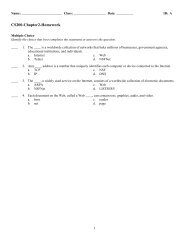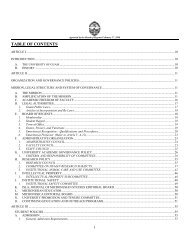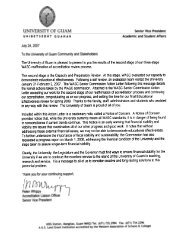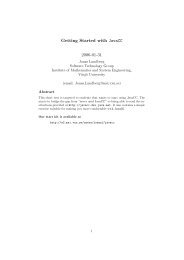ExamView - Chap9-Hwk-and-Solutions.tst
ExamView - Chap9-Hwk-and-Solutions.tst
ExamView - Chap9-Hwk-and-Solutions.tst
You also want an ePaper? Increase the reach of your titles
YUMPU automatically turns print PDFs into web optimized ePapers that Google loves.
Name: ________________________ Class: ___________________ Date: __________<br />
ID: A<br />
CS200-Chapter9-Homework<br />
Multiple Choice<br />
Identify the choice that best completes the statement or answers the question.<br />
____<br />
____<br />
____<br />
____<br />
____<br />
1. A(n) ____ is a collection of data organized in a manner that allows access, retrieval, <strong>and</strong> use of that data.<br />
a. database c. spreadsheet<br />
b. server d. webbase<br />
2. ____ is a collection of unprocessed items, which can include text, numbers, images, audio, <strong>and</strong> video.<br />
a. Integrity c. Synthesis<br />
b. Data d. Information<br />
3. A field ____ uniquely identifies each field.<br />
a. tag c. signal<br />
b. name d. basis<br />
4. The field ____ defines the maximum number of characters a field can contain.<br />
a. medium c. size<br />
b. scope d. identifier<br />
5. The data ____ specifies the kind of data a field can contain <strong>and</strong> how the field is used.<br />
a. type c. size<br />
b. scope d. identifier<br />
____<br />
6. In the accompanying figure, a data ____ is a collection of related records stored on a storage medium such as<br />
a hard disk, CD, or DVD.<br />
a. scope c. segment<br />
b. file d. sector<br />
1
Name: ________________________<br />
ID: A<br />
____<br />
____<br />
7. In a database file like the one shown in the accompanying figure, a(n) ____ key field uniquely identifies each<br />
record in a file.<br />
a. primary c. foreign<br />
b. secondary d. tertiary<br />
8. ____ is the process of comparing data with a set of rules or values to find out if the data is correct.<br />
a. Concatenation c. Digit checking<br />
b. Validation d. Integration<br />
____<br />
9. A(n) ____ check run on the data shown in the accompanying figure ensures that users enter only alphabetic<br />
data into a field.<br />
a. alphabetic c. integration<br />
b. range d. integrity<br />
____ 10. A(n) ____ check run on the data shown in the accompanying figure determines whether a number is within a<br />
specified range.<br />
a. range c. insertion<br />
b. index d. integer<br />
____ 11. A(n) ____ digit is a number(s) or character(s) that is appended to or inserted in a primary key value.<br />
a. check c. insertion<br />
b. index d. integer<br />
2
Name: ________________________<br />
ID: A<br />
____ 12. In a typical file ____ system, each department or area within an organization has its own set of files.<br />
a. synthesis c. analysis<br />
b. processing d. integration<br />
____ 13. When a company uses a(n) ____, many programs <strong>and</strong> users share the data in a database.<br />
a. front-end c. database<br />
b. concatenated d. memory-based<br />
____ 14. Which of the following statements is not true of file processing systems?<br />
a. the records in one file relate to the records in other files<br />
b. they have redundant data<br />
c. they isolate data<br />
d. maintenance tasks consume additional time<br />
____ 15. Which statement does not apply to the database approach?<br />
a. it requires less memory than file processing systems<br />
b. it increases the data’s integrity<br />
c. programs are easier <strong>and</strong> faster to develop than with a file processing system<br />
d. it allows nontechnical users to access <strong>and</strong> maintain data<br />
____ 16. Which of the following DBMSs will run only on a server or mainframe?<br />
a. Adabas c. Access<br />
b. SQL Server d. ObjectStore<br />
____ 17. A data ____ contains data about each file in the database <strong>and</strong> each field within those files.<br />
a. log c. model<br />
b. warehouse d. dictionary<br />
____ 18. A ____ consists of simple, English-like statements that allow users to specify the data to display, print, or<br />
store.<br />
a. query language c. form<br />
b. query-by-example d. report generator<br />
____ 19. A(n) ____ is a request for specific data from the database.<br />
a. capture c. form<br />
b. report d. query<br />
____ 20. Most DBMSs include a(n) ____ feature, like the one in the accompanying figure, which has a graphical user<br />
interface to assist users with retrieving data.<br />
a. QBE c. QBA<br />
b. MTA d. SQL<br />
____ 21. A(n) ____ is a window on the screen that provides areas for entering or changing data in a database.<br />
a. analog c. report<br />
b. form d. backup<br />
3
Name: ________________________<br />
ID: A<br />
____ 22. A ____ allows users to design a report on the screen, retrieve data into the report design, <strong>and</strong> then display or<br />
print the report like the one shown in the accompanying figure.<br />
a. query form c. report table<br />
b. report generator d. recovery utility<br />
____ 23. ____ backup is a backup plan in which all data is backed up whenever a change is made.<br />
a. Ongoing c. Continuous<br />
b. Integrated d. Complex<br />
____ 24. More complex DBMSs maintain a(n) ____, which is a listing of activities that change the contents of the<br />
database.<br />
a. report c. glossary<br />
b. index d. log<br />
____ 25. A DBMS that creates a log usually provides a(n) ____.<br />
a. validity check c. backup<br />
b. integrity check d. recovery utility<br />
____ 26. A(n) ____ uses the logs <strong>and</strong>/or backups to restore a database when it becomes damaged or destroyed.<br />
a. redundancy c. recovery<br />
b. reboot d. refresh<br />
____ 27. A(n) ____ model consists of rules <strong>and</strong> st<strong>and</strong>ards that define how the database organizes data.<br />
a. st<strong>and</strong>ards c. rules-based<br />
b. data d. object-relational<br />
____ 28. A(n) ____ database stores data in tables that consist of rows <strong>and</strong> columns.<br />
a. relational c. object-oriented<br />
b. hierarchical d. multidimensional<br />
____ 29. A developer of a relational database refers to a file as a(n) ____.<br />
a. integration c. st<strong>and</strong>ard<br />
b. tuple d. relation<br />
4
Name: ________________________<br />
ID: A<br />
____ 30. A(n) ____ is a connection within the data in a database.<br />
a. table c. row<br />
b. column d. relationship<br />
____ 31. A developer of a relational database refers to a file as a(n) ____.<br />
a. tuple c. attribute<br />
b. table d. relation<br />
____ 32. A developer of a relational database refers to a field as a(n) ____.<br />
a. unit c. tuple<br />
b. attribute d. table<br />
____ 33. A user of a relational database refers to a file as a(n) ____.<br />
a. unit c. table<br />
b. attribute d. tuple<br />
____ 34. A user of a relational database refers to a record as a(n) ____.<br />
a. unit c. column<br />
b. tuple d. row<br />
____ 35. ____ is a query language, an example of which is shown in the accompanying figure, that allows users to<br />
manage, update, <strong>and</strong> retrieve data.<br />
a. SQL c. XML<br />
b. QBE d. QBA<br />
____ 36. A(n) ____ is an item that contains data, as well as the actions that read or process the data.<br />
a. unit c. index<br />
b. object d. key<br />
____ 37. A(n) ____ is a database that stores data in objects.<br />
a. QBA c. OODB<br />
b. SQL d. QBE<br />
____ 38. A data ____ is a huge database that stores <strong>and</strong> manages the data required to analyze historical <strong>and</strong> current<br />
transactions.<br />
a. stockyard c. storehouse<br />
b. warehouse d. storage unit<br />
____ 39. A database ____ decides on the proper placement of fields, defines the relationship among data, <strong>and</strong> identifies<br />
users’ access privileges.<br />
a. administrator c. analyst<br />
b. manager d. leader<br />
5
Name: ________________________<br />
ID: A<br />
____ 40. A database administrator _____.<br />
a. requires a more technical view of data c. monitors the performance of the database<br />
b. creates <strong>and</strong> maintains the data dictionary d. all of the above<br />
True/False<br />
Indicate whether the statement is true or false.<br />
____ 41. Accurate information is error free.<br />
____ 42. Most information is important only to certain people or groups of people.<br />
____ 43. A database uses characteristics such as field size <strong>and</strong> data type to define each field.<br />
____ 44. Each record in a file like the one in the accompanying figure contains the same fields, but each field contains<br />
different data.<br />
____ 45. One reason users change a record in a file like the one in the accompanying figure is to update old data with<br />
new data.<br />
____ 46. A flagged record is deleted physically, meaning that the program will not process it.<br />
6
Name: ________________________<br />
ID: A<br />
____ 47. Validity checks like those performed on the data in the accompanying figure increase data entry errors.<br />
____ 48. An alphabetic check performed on the data in the accompanying figure would ensure that users enter only<br />
alphabetic or numeric data into a field.<br />
____ 49. A check digit cannot be used to confirm the accuracy of a primary key value.<br />
____ 50. Sharing data from multiple, separate files is complicated <strong>and</strong> usually requires the experience of a computer<br />
programmer.<br />
____ 51. Data redundancy in a data storage system always decreases the chance of errors.<br />
____ 52. When users modify data in a database using the database approach, they must make changes to all files<br />
instead of just one file.<br />
____ 53. The data in a database usually is shared over a network by the entire organization.<br />
____ 54. Companies that use databases do not require security settings for access control.<br />
____ 55. Databases require more processing power than file processing systems.<br />
7
Name: ________________________<br />
ID: A<br />
____ 56. Data in file processing systems is more vulnerable than data in a database.<br />
____ 57. A database can store a lot of data in a single file.<br />
____ 58. A person must be trained in programming languages to learn a query language.<br />
____ 59. Most DBMSs allow different levels of access privileges to be identified for each field in the database.<br />
____ 60. A data model defines how the operating system actually arranges the data on the disk.<br />
____ 61. A user of a relational database refers to a record as a column.<br />
____ 62. All object-oriented databases support object query language (OQL).<br />
____ 63. A smaller version of a data warehouse is a data mart, which contains a database that helps a specific group or<br />
department make decisions.<br />
____ 64. A Web database usually resides on a database server.<br />
____ 65. The maintenance of a database is an ongoing task that companies measure constantly against overall goals.<br />
8


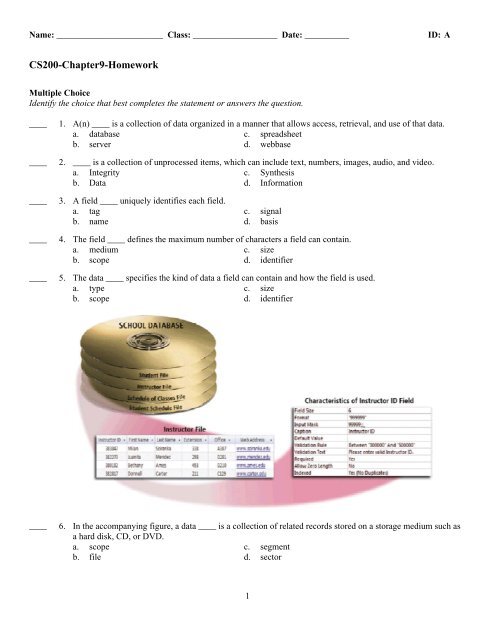


![Residence Hall Application Form [PDF]](https://img.yumpu.com/46340085/1/190x245/residence-hall-application-form-pdf.jpg?quality=85)
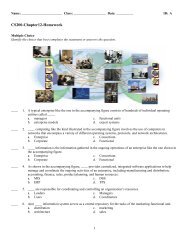

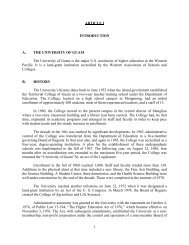
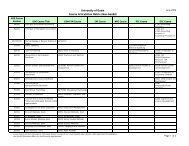
![Modern compiler design [PDF]](https://img.yumpu.com/37285279/1/190x245/modern-compiler-design-pdf.jpg?quality=85)
